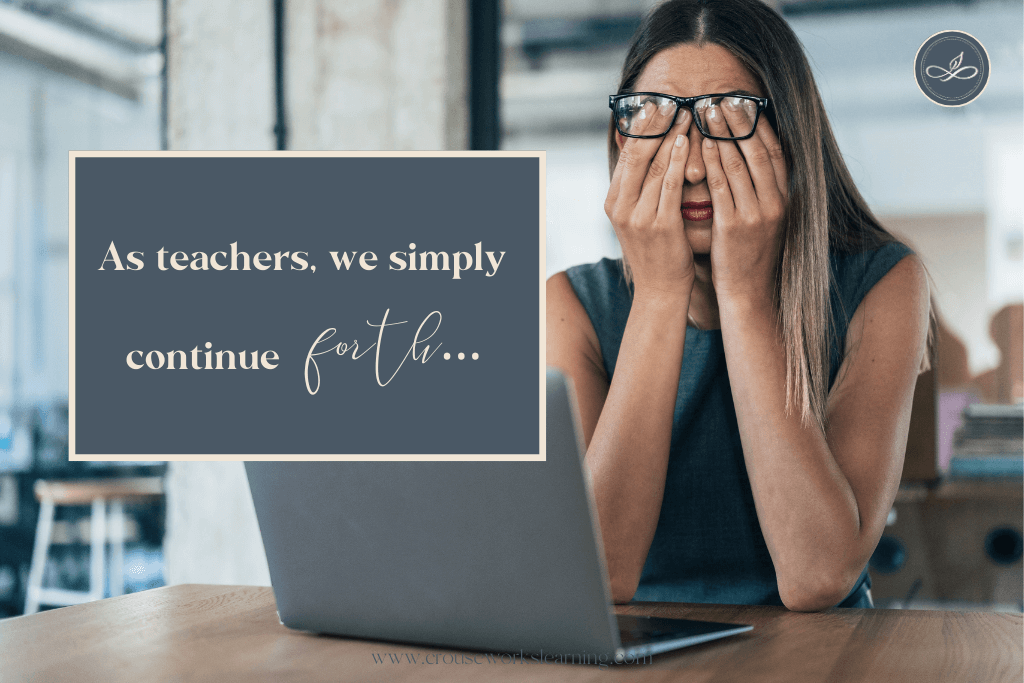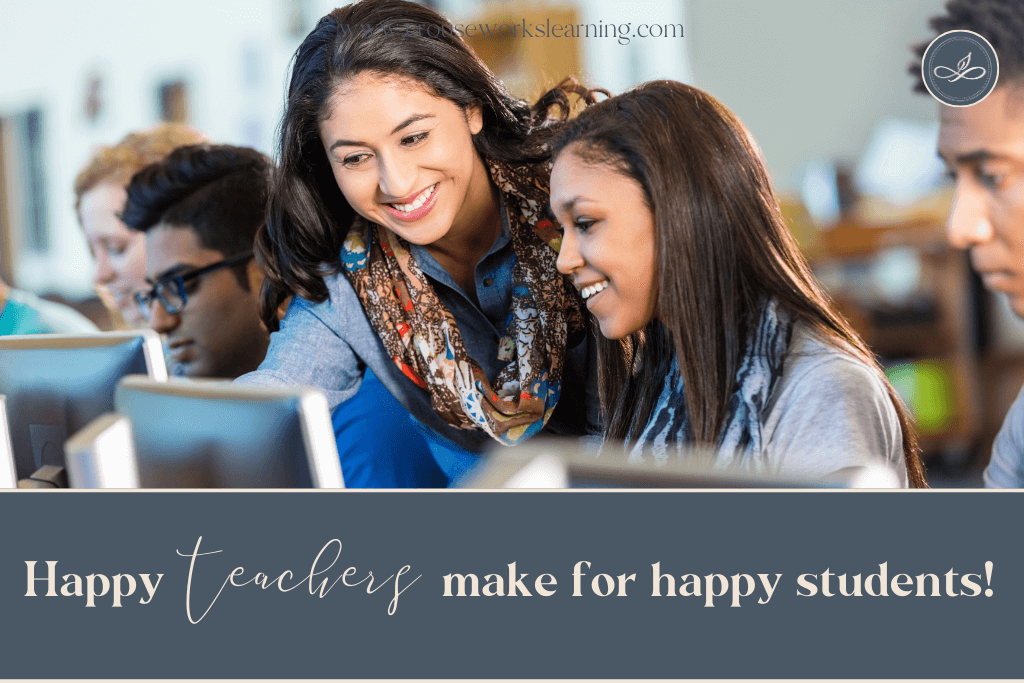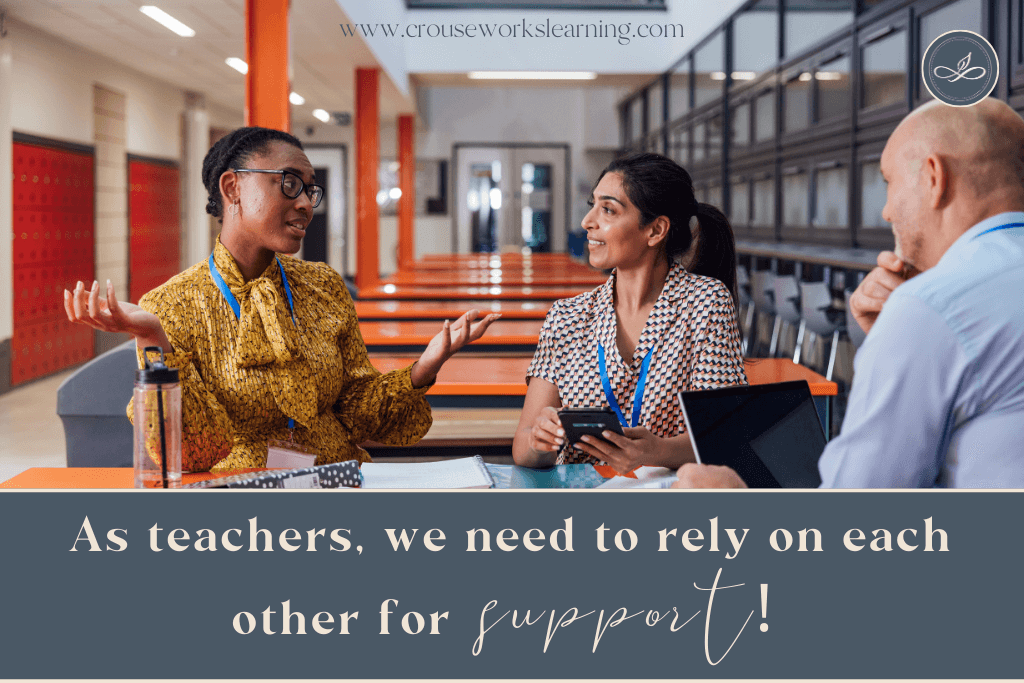Ahhhhhh, work-life balance and teaching sustainability… let’s talk about it…
So, my teacher friend- let’s paint a picture here…
By now you have been around the block or two. You’re a couple years into teaching. You know how to manage a classroom. You know how to scaffold your lessons. You know how to align your objectives with the state standards. You can do everything that is asked of you…
The one problem is… you feel like you’re slowly losing your mind, your work-life boundaries are totally out of whack, and some days you come home without an ounce of strength left.
Sound familiar at all?
Well, then, you are in luck because that is what this post is all about!
I must say, it is a profound moment as a teacher- once you climb that mountain of success in the classroom. Taking years and years to get there. Having learned all the tricks of the trade, the secret hacks and teacher shortcuts, finally being able to juggle 10 apples, 5 pencils, 2 books, and 35 children all at once.
And now you are at the top of the mountain, and alas, you’ve come upon the surprising conclusion that…
You must simply continue forth.
Yes, you heard me right; you simply continue forth. No putting your juggling toys down, getting off the carousel, or “arriving” at your destination. You just keep going.
Because while yes… over time, teaching naturally does get EASIER in many ways… if we’re not careful, it also remains DIFFICULT in many ways.

Hmmmmm… have I got your attention yet? Am I ringing any bells?
Good.
Because this is where we’re going to start turning things around.
We’ve heard it all before, “We need to care for ourselves as teachers.” “As teachers, we need to get off the rat wheel.” “As teachers, we must start putting our needs first to make it over the long haul.”
But, all cliches and platitudes aside, do you know WHY people keep saying that to us?
It’s because, as everyone can attest nowadays, what we need MORE than good teachers in the classroom is good teachers who LOVE being in the classroom.
I will never forget during my first year in the classroom- my administrator said something to me about teacher sustainability that absolutely shook me to my core…
Let me back up first and provide you with some context though.
You see, as a first-year teacher at the time, I was trying to do all the things. I was trying to spin all the plates, juggle all the needs, and put on all the hats. I was very much what you would call one of those type A, control freak, “I can do it all because I’ve never earned a bad grade in my life” type of new teachers…
And my administrator saw all that. And instead of being elated at my work ethic, exuberance, and passion for all things teacher-y… she was becoming concerned.
Because what she saw in that moment was that I was also a candle burning at both ends- a shooting star in the night, quickly set to fade.
And one day my administrator took me aside, after what I perceived to be the best science lesson ever given to all humankind. And she said to me in the calmest, kindest way possible, “Claire… happy teachers make for happy students.” And that is all she said to me.
What?! Talk about a bombshell moment.
Happy-teachers-make-for-happy-students.
That’s alllllll she said??
What about… die-hard-teachers-make-for-classrooms-to-die-for??
Or… eager-and-effervescent-educators-earn-ethusiastic-engagement-from-teenagers??
Yep. Couldn’t believe it. That’s all she said.
But you know what… 10 years into this job- sweet Nettie was right. Happy teachers make for happy students.

As teachers, we easily get caught up in alllllll the things that we have to do, that we’re not doing, that we’re supposed to do but didn’t do right and have to go back and do again… so easily, in fact, that we quickly forget the one guiding principle that underlines all of teaching, “Happy teachers make for happy students.”
In short, you cannot give your students what you don’t yet possess yourself.
Which is why it was important for me to start this blog post (on teacher sustainability!) with that story. That philosophy of “happy teachers make for happy students” underlies all of the following strategies I’m about to give you for creating systems in your science classroom that work.
The goal of these systems is not so you can get more things done in a day and feel even more efficient and effective as a teacher. Rather the goal of these systems is for you to feel HAPPIER as a teacher, for you to ENJOY being in the classroom, and for you to LOOK FORWARD to spending time with your students. Because that is what really matters at the end of the day
So, with that being said, now that we have some big-picture philosophies under our belt, let’s dive into some practical strategies to make YOU happier as a teacher in the classroom!
TIP #1: Add flex days to your calendar
Don’t love the announcements going off just as you’re about to give the most poignant line in your lesson? Tired of fire drills interrupting your lab days? Confused as to why there’s an assembly that’s just been announced over the intercom that you had no notice about? Yep, welcome to our public school system. It took me years… and I mean yeeeaaarrrrssss… to accept (and eventually embrace) the chaotic nature of school days. That is why I started adding “flex days” to my curriculum calendar.
As teachers, the sooner we embrace that our lessons will get cut off, go too long, or be sideswiped by a million other things in the average week, the HAPPIER we will be. And to make it even easier for ourselves, why not just add flex days to our calendars? Give ourselves a bit of wiggle room as needed. I promise, you and your students would be very grateful for a day either every couple weeks or months to get caught up on unfinished lessons, missing assignments, and incomplete labs; you name it!
For example, check out my unit calendar for when I teach genetics and heredity. You’ll notice it is riddled with flex days because I like having some cushion after certain lessons.
Flex days are great! Embrace them
TIP #2: Embrace student-driven work
Maybe it is just me… but I feel like, as a teacher- I’ve actually become more introverted over time. I used to love standing up in the front of the room, inflecting my intonation to hit key points in my lessons, and gesturing grandly with my hands to really get my lesson objectives to sink in with students.
Nowadays though, I prefer to let students take the wheel. As much as I can, I try to include student-driven inquiry work in my classes. Sometimes, the inquiry involves hands-on labs, and sometimes, it involves just simple minds-on activities, such as those you can find in POGIL (click here).
Now granted, you should take this strategy with a grain of salt because there’s an art to inquiry. You can’t just throw kids into the ocean and ask them to swim. There’s a dance that has to happen between inquiry and direct instruction. But that is a much bigger topic than I have time for today. That needs a blog post all by itself.
In the meantime, though, I cannot tell you how freeing it is for me (and students) to let them work independently or collaboratively on student-driven inquiry work. It takes you off the performance stage, AND students are much more bought into your lessons!

TIP #3: Rely on other teachers for resources
My goodness, we are so quick to silo ourselves as teachers, aren’t we? It’s like- if you gave us a rock and a chisel and said, “Here, make a wheel”- we would just jump right to it- without any hesitation or question at all. I mean, what is up with us and the need to invent fire for every lesson?!
Okay… so I’m going to let you in on an important secret here. And this is a big one. It’s one of those “Nettie” truth bombs coming at you. It’s about letting go of the need to control everything in your lessons and make it all perfect. Are you ready?
The aim of good instruction is not uniqueness; it is not trying to discover what no one else has ever done before. The aim of good instruction is simple: supporting students in mastering the content objective and skills.

Wow, truth bomb alert, am I right?!
Okay, so what do we do with this little nugget of wisdom? How do we make it practical? Where do we go from here?
Well, let’s pause for a moment and think… Going into this next week of instruction. What would it look like for you to shift your perspective a bit? To go from “discovering fire” to “walking over to a campfire already built and enjoying yourself by it?”
And what I mean by this is… Are there any free resources you can use (and modify)? Instead of spending hours trying to create your own from scratch? Think about… are there any free resources you can get your hands on either from your textbook, department peers, your district’s learning management hub, or subject-specific Facebook teaching groups?
Remember, the goal for this next week is to support students in achieving the content objective and skills. So what does that look like in a more REALISTIC and PRACTICAL manner… pssst because when you do that… I promise you’re gonna enjoy teaching sooooo much more!

TIP #4: Take your foot off the pedal
The beauty of teaching secondary science classes is that as much as we want to say, as teachers, that kids have to get through the entire curriculum to “stay on pace” with their education…. The truth is, there really are no hard and firm deadlines for kids mastering science content or skills.
Yes, sometimes we’re asked to prepare kids for district science assessments, but I have never actually been at a school where those district assessments were considered that critical in the grand scheme of things. What schools care much more about these days are kids actually passing our classes, graduating from high school, and how they are performing on the SAT (which, even that, is being fazed out).
Now, AP and CTE science classes are a different story. AP and CTE curriculums require you to stay on track so kids are prepared for college placement and certification exams. However, all other science classes are much more flexible.
Which means… the hard (but freeing) truth is that as science teachers, we have control over the amount of pressure we put on ourselves (and our students) to get through the curriculum. And I hope that comes as a relief to you. You have more power over your stress than you realize. And it is sooooo much more important anyway that the content and skills you do cover are taught thoroughly and with fidelity than it ever is getting through the entire curriculum sequence. In fact, I promise if you allow students to take more time with things, everyone will be happier in your classroom!

TIP #5: Set up systems that work for you
I would be remiss if, in this sustainability blog, I didn’t at least once mention the systems I have in place for those more tedious tasks we have to complete as teachers. Whether it’s lab setup, clean up, grading papers, or having to document classroom situations, it’s essential to have systems that work for you. Especially so you can more quickly get yourself back to the genuinely critical tasks, like lesson planning and interacting with students.
So, what are my general rules of the road regarding sustainable systems? Well, let’s take a look at a few…
- LAB SET-UP AND CLEAN-UP: As science teachers, we need to give ourselves permission to NOT conduct experiments all the time. Running a demonstration or experiment every day is just too much work (and quite frankly, the novelty for students will quickly wear off). Therefore, I limit my labs to once a week. It makes my life easier as a teacher- less materials to set up, less to clean up, and the novelty stays intact.
- GRADING: I grade wayyyy fewer assignments than ever now. And the ones I do grade, I typically let students grade themselves (more on that here).
- PARENT COMMUNICATION: Now, lastly, for parent communication- I got lucky in that my school integrates Blackboard Connect into our school platform. This allows teachers to seamlessly email and leave voice messages for groups of parents and students at a time. If your district doesn’t have this, I recommend advocating for it. It’s a real game-changer!
To wrap up...
Alas, so teacher sustainability. We’ve covered a lot in this post, haven’t we? Didn’t go quite the way you expected when you first opened up this post, did it? Yes, you see, I snagged you on that catchy blog title and picture, my friend. But wasn’t it worth it?!
I hope you’ve found some inspiration in this post. And more importantly, I hope you’ve found some practical, realistic strategies that will get you back on track again and enjoying your teacher life starting today!

P.S. Are you looking for EVEN MORE inspiration and support in getting your work-life balance back on track??
Then check out my FREE ultimate teacher sustainability guidebook that will become your one-stop shop for getting that pep back in your step and feeling passionate and revved up again for teaching!
This all-in-one guidebook has my top 4 steps for cultivating your dream work-life balance and finding joy again in teaching!
And best news of all- it’s 100% FREE!
So, click below to check it out!


